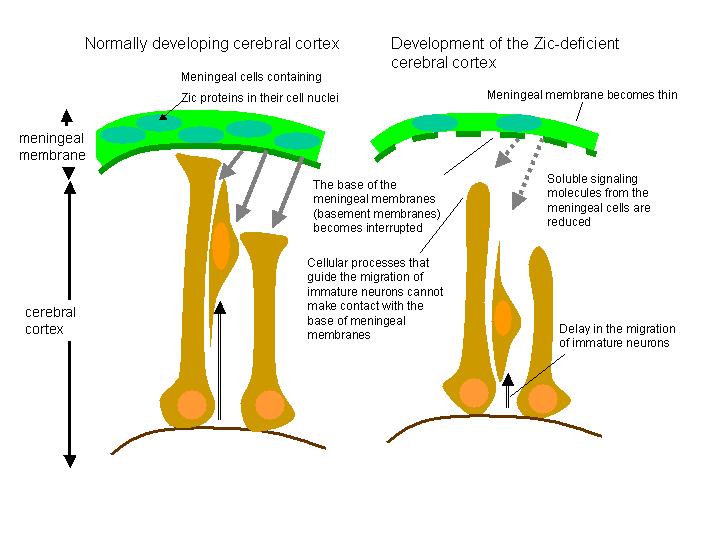|
Home > page titl Recent Advances
Meningeal membranes are required for normal cerebral cortex development (Inoue et al., 2008) Our research target, Zic proteins are placed in cell nuclei and are known to act as a kind of switch that controls the on-off state of several genes. Most Zic-controlling genes are important for cell proliferation and differentiation. It has been known that Zic proteins are produced in immature neural cells to control them. In this study, we found that the Zic proteins are also produced in the cells forming meningeal membrane that cover the surface of brain as a thin sheet containing many blood vessels. The meningeal membrane is formed along the embryonic development after the brain vesicles become apparent. To clarify the role of Zic proteins in the meningeal membrane, we analyzed the meningeal membranes of two strains of Zic-deficient mutant mice. As a result, we revealed that the cell proliferation efficiency is reduced in the animals lacking Zic proteins. This results in the shortage of the cells necessary for the formation of meningeal membrane. Furthermore, Zic is capable of endowing cellular properties of mature meningeal membrane with the immature meningeal membrane-forming cells.
In the course of this research project, we found that Zic-deficient mice have abnormalities not only in the meningeal membranes but also in the cerebral cortex. Mature cerebral cortex generally has a clear laminar structure that is formed in the embryonic development. It is known that immature neurons, which are initially placed in a deeper part of the immature cerebral cortex, migrate toward the brain surface along the process that bridges the deeper layer and the surface where the immature meningeal membranes located. When we examined the Zic-deficient cerebral cortex carefully, there was a distortion of the laminar layer formation. The distortion was not very severe but significant. Detailed examination of the cerebral cortex-forming cels revealed that migration of the immature neurons is delayed in the Zic-deficient cerebral cortex. The distorted laminar layer formation may be caused by the defective attachment of the cellular processes that are normally in touch with the bottom of meningeal cell membranes. Another possible mechanism is the reduction of some soluble signaling molecules from the immature meningeal cells to the migrating neurons. Meningeal membranes has been known to be important for both the mechanical and functional support of the mature brain together with the cranial bones and cerebrospinal fluid. Our results indicate that the meningeal membrane has an important role also in the development of the cerebral cortex.
|
